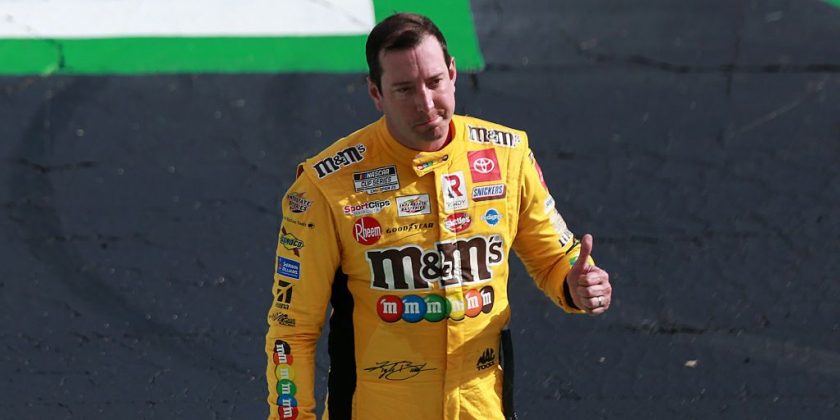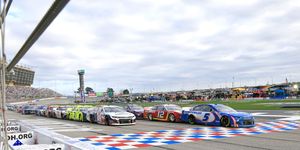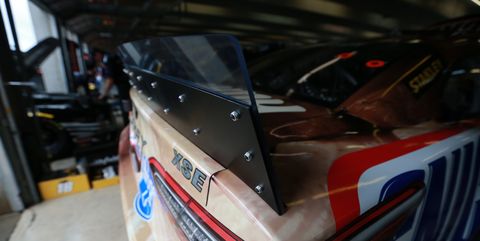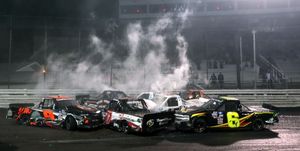In the moments after winning the final NASCAR Xfinity Series race at Atlanta Motor Speedway before the track undergoes a polarizing reprofiling over the summer, and just before beginning a scorching news conference targeting Speedway Motorsports Inc. for recent decisions, Kyle Busch wanted a memento.
The two-time Cup Series champion asked SMI executive Donald Hawk to send him a chunk of pavement after the bulldozers arrive next week.
“Other than getting into my teammate Daniel Hemric and him crashing, I sure am glad to win the final Xfinity Series race on a real Atlanta racetrack,” Busch said. “Because the next one is just going to be a showpiece, and it’s going to be shit.”
For the next 15 minutes, Busch didn’t lift or hold back, the latest Cup Series personality to express reservations over the general direction of the sport and a lack of driver involvement in the decision to reconfigure Atlanta into a pack racing venue like Daytona or Talladega.
To accomplish the goal, SMI will give Atlanta Motor Speedway four extra degrees of banking from 24 to 28 while also narrowing the width of the turns by 14’ in its first reconfiguration and repaving since 1997.
Kyle Larson, Denny Hamlin and Stewart-Haas Racing crew chief Rodney Childers have each taken turns expressing concern over how the intended layout will race.
Busch publicly joined them on Saturday.
“If they’re going to narrow it up 15 feet, whatever it is, that’s the whole bottom groove,” Busch said. “We’re not going to be able to run around here three-wide. You’re going to be stuck at two-wide. It’s going to be as wide as Darlington. So, trying to run around here at 210 mph because if they don’t put plates on it, you’re going to be going way too fast.
“Just think about it. Everybody needs to just think. There ain’t nobody thinking. Brains for sale: Never used, operating racetracks.”
As Speedway Motorsports operations director Steve Swift made clear during a Tuesday press conference, they’re thinking about creating pack racing.
“You’ll see in the renders and simulation that cars are grouped together and that creates better entertainment and better competition for the sport, and definitely for this type of track,” Swift said during a Tuesday press conference. “This will be a first for an intermediate to have this kind of banking.
“It will be the first time an intermediate has been banked over 24 degrees. With all that, the thing our company and Marcus pushes us is to be the first, innovative, and this is definitely that.”
Here’s a taste of the next generation of Atlanta Motor Speedway! 🤩
Details ➡️ https://t.co/X6T7IL05Y0 pic.twitter.com/S5mKOd3tf5
Since the 2019 season, NASCAR has considerably restricted horsepower in the pursuit of creating pack races at intermediate tracks like Atlanta with the Next-Gen car designed with aero ducts intended to off-set the turbulence generated by the current car.
“The Xfinity cars will still be fast; it’s going to be close to wide open,” Busch said. “But the Cup cars, they still don’t even know what aero package they’re bringing for the new Cup car. Are we coming here with the 550-type package? You might as well put the bigger blade on it that we have at the speedways and slow it down because you know you’re going to need to.”
The bigger blade is a reference to the spoilers used at Daytona and Talladega, which are 9” with a 1” wicker. The intermediate tracks currently use the 550-horsepower tapered spacer with a 8” spoiler.
Busch said he first found out about the changes when it was made public to fans and the media. Echoing his peers, he expressed frustration that drivers are not being heard or consulted.
“I feel that our side doesn’t get looked at whatsoever from our vantage point,” he said. “You’re going to come here with fresh pavement with four degrees more banking when they were here in 1997, they went around here wide open and set a track record of 197 mph.
“You’re going to tell me that the (Next Gen) cars that we’re going to have with more tire, wider tire, we’re not going to go faster? So, we’re the ones that need to be consulted as well, too, a little bit.”
Since the low horsepower, high downforce NA18D package was implemented in 2019, SMI and NASCAR have begun widely utilizing traction compounds like PJ1 to widen the racing surface.
Why?
With cars that produce so little power, and so much downforce, the cars are locked down on the bottom of the track — the quickest way around. Needing clean air to complete passes, the traction compound has been sprayed on various intermediate tracks in the hopes of giving drivers a chance at getting downforce on the front of their cars.
Busch doesn’t understand why SMI would take away room to find that clean air given everything the industry has learned about this rules package over the past three years.
“Narrowing a racetrack … all we’ve done at every single racetrack that we’ve gone to over the years is try to widen the racing groove, right?” Busch said. “What do you think the PJ1 bullshit is for? To widen the racing groove.
“We go to Charlotte. We spray this PJ1 stuff in Lane 2 and 3 to make it wider. We go to Texas, we spray it in Lanes 2, 3, 4 at Texas to widen it. What are we doing? Now we’re going to come here and run here like Darlington. I just don’t see it.
“And they want pack racing? You want pack racing two-wide. Who’s going to pass? Where are the lanes going to go? You’re going to get to the straightaway and make it three wide and try to blend back into 2 when you get to the corner.”
While drivers were not consulted, tests were conducted on iRacing and that footage was shared during Tuesday’s press conference announcing the changes.
“But simulation,” Busch said. “They’ve got it worked out.”
Swift explained on Tuesday that drivers were not consulted because their opinions often differ from the intended target audience.
“We tried to do what’s good for the sport, and Marcus does talk to the drivers to gauge feedback on what works well for them and he feeds us that information, and I say this with jest a little,” Swift said, “but when a driver is happy the fans aren’t.
“When fans are happy, drivers aren’t. When you talk to drivers, you get driver tracks and we’re making a fan’s track. We’re taking elements of driver feedback, but we’re ultimately giving the fans what they want to see.”
Hamlin responded by saying tracks should be in the promotional business and not the competition business. Larson says the reconfiguration is about producing crashes because that’s what the industry believes fans want.
“I’ve been in a race I haven’t walked out of,” Busch said referencing a 2015 Xfinity Series crash at Daytona that broke a foot and a leg. “That sucks. I missed 11 races after that. I know what it’s like to get hurt when the opportunity presents itself.
“So, coming back to an Atlanta with higher banking and less race track to race does not sound appealing.”
After a quarter of a century of racing on this surface, and a successful halting of a resurfacing attempt in 2016, Busch understands that it was time … just not for this.
“Overall, this is one of the more fun tracks,” Busch said. “But the asphalt is coming up, so I don’t discredit a repave, but the layout … I can’t get it in my mind that we want to go faster.”
Source: Read Full Article






